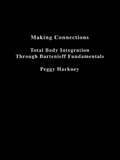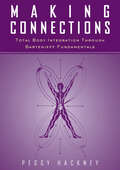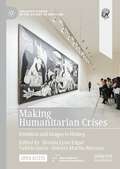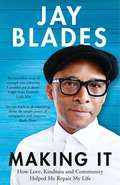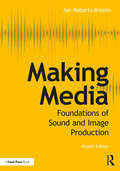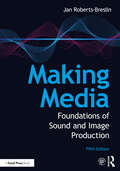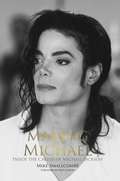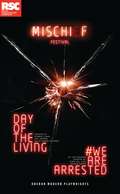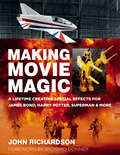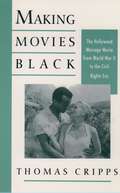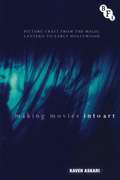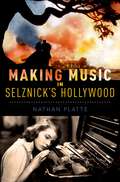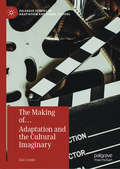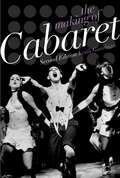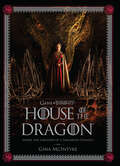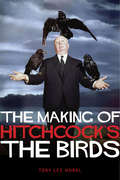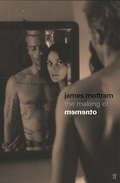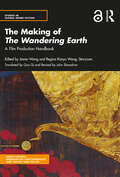- Table View
- List View
Making Connections: Total Body Integration Through Bartenieff Fundamentals
by Peggy HackneyHuman movement influences an individual's perceptions and ability to interact with the world. Through exercises, illustrations, and detailed anatomical drawings, this remarkable book guides the reader toward total body integration. An experimental approach to movement fundamentals involving the patterning of connections in the body according to principles of efficient movement, the process of total body integration encourages personal expression and full psychological involvement.
Making Connections: Total Body Integration Through Bartenieff Fundamentals
by Peggy HackneyHuman movement influences an individual's perceptions and ability to interact with the world. Through exercises, illustrations, and detailed anatomical drawings, this remarkable book guides the reader toward total body integration. An experimental approach to movement fundamentals involving the patterning of connections in the body according to principles of efficient movement, the process of total body integration encourages personal expression and full psychological involvement.
Making Connections: Total Body Integration Through Bartenieff Fundamentals
by Peggy HackneyThis book explores how we go about creating the connections within us that allow us to become fully embodied human beings in the world. It provides some very personal memories of Irmgard Bartenieff and the development of her approach to Fundamentals.
Making Connections: Total Body Integration Through Bartenieff Fundamentals
by Peggy HackneyThis book explores how we go about creating the connections within us that allow us to become fully embodied human beings in the world. It provides some very personal memories of Irmgard Bartenieff and the development of her approach to Fundamentals.
Making Humanitarian Crises: Emotions and Images in History (Palgrave Studies in the History of Emotions)
by Brenda Lynn Edgar Valérie Gorin Dolores Martín-MorunoThis open access collection of essays explores the emotional agency of images in the construction of ‘humanitarian crises’ from the nineteenth century to the present. Using the prism of the histories of emotions and the senses, the chapters examine the pivotal role images have in shaping cultural, social and political reactions to the suffering of others and to the establishment of the international networks of solidarity. Questioning certain emotions assumed to underlie humanitarianism such as sympathy, empathy and compassion, they demonstrate how the experience of such emotions has shifted over time. Understanding images as emotional objects, contributors from a wide horizon of disciplines explore how their production, circulation and reception has been crucial to the perception of humanitarian crises in a long-term historical perspective.
Making It: How Love, Kindness and Community Helped Me Repair My Life
by Jay BladesThe Sunday Times bestseller by Jay Blades, the beloved star of hit BBC One show The Repair Shop. Making It is an inspirational memoir about beating the odds and turning things around even when it all seems hopeless.We had our hardships, and there were times that we didn’t have a lot of food and didn’t have a lot of money. But that didn’t stop me having the time of my life.In his book, Jay shares the details of his life, from his childhood growing up sheltered and innocent on a council estate in Hackney, to his adolescence when he was introduced to violent racism at secondary school, to being brutalized by police as a teen, to finally becoming the presenter of the hit primetime show The Repair Shop.Jay reflects on strength, weakness and what it means to be a man. He questions the boundaries society places on male vulnerability and how letting himself be nurtured helped him flourish into the person he is today. An expert at giving a second life to cherished items, Jay’s positivity, pragmatism and kindness shine through these pages and show that with care and love, anything can be mended.
Making Media: Foundations of Sound and Image Production
by Jan Roberts-BreslinMaking Media: Foundations of Sound and Image Production takes the media production process and deconstructs it into its most basic components. Students will learn the basic concepts of media production – frame, sound, light, time, motion, and sequencing – and be able to apply them to any medium they choose, from film and television to fine art and online applications. They will also become well-grounded in the digital work environment and the tools required to produce media in today’s digital environment. This new fourth edition is completely updated and includes a new chapter on the production process and production safety; information on current trends in production, exhibition, and distribution; and much more. New topics include virtual and augmented reality, the use of drones and new practices interactive media. The text is also fully illustrated and includes sidebar discussions of pertinent issues throughout. The companion website has been completely revamped with interactive exercises for each chapter, allowing students to explore the process of media production.
Making Media: Foundations of Sound and Image Production (Making Media: Foundations Of Sound And Image Production Ser.)
by Jan Roberts-BreslinMaking Media: Foundations of Sound and Image Production takes the media production process and deconstructs it into its most basic components. Students will learn the basic concepts of media production – frame, sound, light, time, motion, and sequencing – and be able to apply them to any medium they choose, from film and television to fine art and online applications. They will also become well-grounded in the digital work environment and the tools required to produce media in today’s digital environment. This new fourth edition is completely updated and includes a new chapter on the production process and production safety; information on current trends in production, exhibition, and distribution; and much more. New topics include virtual and augmented reality, the use of drones and new practices interactive media. The text is also fully illustrated and includes sidebar discussions of pertinent issues throughout. The companion website has been completely revamped with interactive exercises for each chapter, allowing students to explore the process of media production.
Making Media: Foundations of Sound and Image Production
by Jan Roberts-BreslinTaking essential media production processes, this book deconstructs them into the most basic components. Students will learn the concepts of media production – frame, sound, light, time, motion, and sequencing – and be able to apply them to any medium they choose, from film and television to fine art and online applications. They will also become well-grounded in the digital work environment and the tools required to produce media in today’s digital environment. The primacy of content and the importance of an ethical approach to media making are also emphasized. This new fifth edition is fully updated throughout, featuring updates on technology and processes. Included is new information on shooting with a cell phone, developments in mirrorless cameras, color grading, tips for recording good audio, intimacy training, and much more. Fully illustrated, this book includes sidebar discussions of pertinent issues throughout. There is a companion website with interactive exercises for each chapter, allowing students to explore the process of media production. This book is ideal for media students on courses including media production, film production, audio production, and photography.
Making Media: Foundations of Sound and Image Production
by Jan Roberts-BreslinTaking essential media production processes, this book deconstructs them into the most basic components. Students will learn the concepts of media production – frame, sound, light, time, motion, and sequencing – and be able to apply them to any medium they choose, from film and television to fine art and online applications. They will also become well-grounded in the digital work environment and the tools required to produce media in today’s digital environment. The primacy of content and the importance of an ethical approach to media making are also emphasized. This new fifth edition is fully updated throughout, featuring updates on technology and processes. Included is new information on shooting with a cell phone, developments in mirrorless cameras, color grading, tips for recording good audio, intimacy training, and much more. Fully illustrated, this book includes sidebar discussions of pertinent issues throughout. There is a companion website with interactive exercises for each chapter, allowing students to explore the process of media production. This book is ideal for media students on courses including media production, film production, audio production, and photography.
Making Michael: Inside the Career of Michael Jackson
by Mike SmallcombeMAKING MICHAEL delves deep inside the career of one of the most successful, enigmatic and controversial entertainers of all time: Michael Jackson. Side-stepping sensationalism, journalist Mike Smallcombe enters unchartered territory as he takes you behind the scenes to reveal the real Jackson, a man few people ever got to know. Interviewing over sixty of Jackson’s associates including managers, lawyers, music executives, producers, musicians and engineers - many of whom are speaking about their experiences publicly for the first time - he provides exclusive access to one of the biggest-selling recording artists in history. Featuring a foreword by Matt Forger, one of Jackson’s longest serving and most loyal collaborators, MAKING MICHAEL takes readers into the studio with the King of Pop, charting the creation of record-breaking albums including Thriller, Bad, Dangerous and HIStory and the twists and turns that occurred along the way. Untold stories, revelations and secrets finally see the light of day as Jackson’s career outside the studio is also examined. Smallcombe remains objective and doesn’t shy away from exploring Jackson’s ruthless traits, his addictions, his fall outs, the relentless pursuit of perfectionism, the financial chaos and those shocking final weeks. MIKE SMALLCOMBE is a British journalist living and working in the UK. www.makingmichael.co.uk Twitter: @mikesmallcombe1
Making Mischief: We Are Arrested; Day of the Living (Oberon Modern Playwrights)
by VariousWE ARE ARRESTED By Can Dündar Adapted by Pippa Hill and Sophie Ivatts When a journalist receives a flash-drive containing critical evidence of illegal government activity, he is duty-bound to publish the story. But with the nation destabilised and divided, a sinister power is eroding the rule of law, and he soon finds himself risking everything for his profession. We Are Arrested is the true story of a journalist’s commitment to expose the truth in the face of huge personal risks. This deeply moving play is a tribute to the bravery of journalists under threat around the globe. #WeAreArrested DAY OF THE LIVING Created by Darren Clark, Amy Draper and Juliet Gilkes Romero Ayotzinapa, Mexico, 2014. Forty-three students are forcefully disappeared. No one is brought to justice. An anarchic, musical tribute to life and the Mexican spirit with urgent, global issues at its heart. #NosFaltan43 #HastaEncontrarlos #AyotzinapaSomosTodos
Making Movie Magic: A Lifetime Creating Special Effects for James Bond, Harry Potter, Superman & More
by John RichardsonJOHN RICHARDSON is an Oscar-winning special effects supervisor and designer, who has been involved in over 100 movies, including nine James Bond adventures, all eight Harry Potter films, Aliens, Superman, A Bridge Too Far, Straw Dogs, The Omen, Cliffhanger, Far and Away, Willow . . . and many, many more. In creating the magic that flows through these films – by creating huge explosions, beheading people, producing futuristic gadgets, making a man fly or breathing life into creatures that amaze and haunt us – Richardson has come to hold a unique place in cinema history. The son of pioneering FX technician Cliff Richardson, he learned his trade at the feet of a master of the craft. With over five decades of adventures under his belt, and a vast photographic collection of unseen pictures, Richardson now lifts the lid on his exciting and fascinating career of making movie magic.
Making Movies Black: The Hollywood Message Movie from World War II to the Civil Rights Era
by Thomas CrippsThis is the second volume of Thomas Cripps's definitive history of African-Americans in Hollywood. It covers the period from World War II through the civil rights movement of the 1960s, examining this period through the prism of popular culture. Making Movies Black shows how movies anticipated and helped form America's changing ideas about race. Cripps contends that from the liberal rhetoric of the war years--marked as it was by the propaganda catchwords brotherhood and tolerance--came movies that defined a new African-American presence both in film and in American society at large. He argues that the war years, more than any previous era, gave African-American activists access to centers of cultural influence and power in both Washington and Hollywood. Among the results were an expanded black imagery on the screen during the war--in combat movies such as Bataan, Crash Dive, and Sahara; musicals such as Stormy Weather and Cabin in the Sky; and government propaganda films such as The Negro Soldier and Wings for this Man (narrated by Ronald Reagan!). After the war, the ideologies of both black activism and integrationism persisted, resulting in the 'message movie' era of Pinky, Home of the Brave, and No Way Out, a form of racial politics that anticipated the goals of the Civil Rights Movement. Delving into previously inaccessible records of major Hollywood studios, among them Warner Bros., RKO, and 20th Century-Fox, as well as records of the Office of War Information in the National Archives, and records of the NAACP, and interviews with survivors of the era, Cripps reveals the struggle of both lesser known black filmmakers like Carlton Moss and major figures such as Sidney Poitier. More than a narrative history, Making Movies Black reaches beyond the screen itself with sixty photographs, many never before published, which illustrate the mood of the time. Revealing the social impact of the classical Hollywood film, Making Movies Black is the perfect book for those interested in the changing racial climate in post-World War II American life.
Making Movies into Art: Picture Craft from the Magic Lantern to Early Hollywood (Cultural Histories of Cinema)
by Kaveh AskariFocusing on early cinema's relationship with the pictorial arts, this pioneering study explores how cinema's emergence was grounded in theories of picture composition, craft and arts education – from magic lantern experiments in 1890s New York through to early Hollywood feature films in the 1920s. Challenging received notions that the advent of cinema was a celebration of mechanisation and a radical rejection of nineteenth-century traditions of representation, Kaveh Askari instead emphasises the overlap between craft traditions and modernity in early film. Opening up valuable new perspectives on the history of film as art, Askari links American silent cinema with the practice of teaching the public how to appreciate fine art; charts its entrance into arts education via art schools and university film courses;shows how concepts of artistic production entered films through a material interest in the studio; and examines the way in which Maurice Tourneur and Rex Ingram made early art films by shaping an image of the film director around the idea of the fine artist.
Making Music in Selznick's Hollywood (Oxford Music/Media Series)
by Nathan PlatteThrough the rise and fall of the Hollywood studio system, David O. Selznick reigned as Hollywood's preeminent producer. His reputation depended in large part on music. The orchestral cacophony of King Kong, the pulsing electronic sonorities of Spellbound, and the Tara theme from Gone with the Wind made music a distinguishing feature of the Selznick experience. By flaunting music's role in film and overseeing its distribution through sheet music, concerts, radio broadcasts, and soundtrack albums, Selznick cultivated a fascination with film scores. But he did not do it alone. In Making Music in Selznick's Hollywood, Nathan Platte brings to light the men and women whose work sounds throughout Selznick's many films. The cast includes familiar composers like Max Steiner, Franz Waxman, and Dimitri Tiomkin, but extends to overlooked contributors, including music editor Audray Granville, orchestrator Hugo Friedhofer, harpist Louise Klos, choral director Jester Hairston, publicist Ted Wick, and many others. Novelists, studio writers, and directors like Alfred Hitchcock also influenced the soundscapes of Selznick's films. Whether working with the producer directly or managing his presence from a distance, all had to reckon with Selznick's musical preoccupations. Rarely was it easy. Rewritten scores, fired personnel, and other skirmishes reflect the troubles-and uneven compromises-that shaped music for films like Gone with the Wind, Duel in the Sun, and Rebecca. Even Selznick anticipated that such problems would "go down in the history of Hollywood as the last wild fling of people who really fiddled-and how!-while Hollywood burned." Drawing on extensive archival research, Platte recounts those stories here, tracing Selznick's musical labors during the silent era through his work at the major studios and his culminating efforts at Selznick International Pictures. Taken together, Selznick's films provide a sweeping vista of the relationships among musicians and filmmakers that defined the Hollywood sound.
Making Music in Selznick's Hollywood (Oxford Music/Media Series)
by Nathan PlatteThrough the rise and fall of the Hollywood studio system, David O. Selznick reigned as Hollywood's preeminent producer. His reputation depended in large part on music. The orchestral cacophony of King Kong, the pulsing electronic sonorities of Spellbound, and the Tara theme from Gone with the Wind made music a distinguishing feature of the Selznick experience. By flaunting music's role in film and overseeing its distribution through sheet music, concerts, radio broadcasts, and soundtrack albums, Selznick cultivated a fascination with film scores. But he did not do it alone. In Making Music in Selznick's Hollywood, Nathan Platte brings to light the men and women whose work sounds throughout Selznick's many films. The cast includes familiar composers like Max Steiner, Franz Waxman, and Dimitri Tiomkin, but extends to overlooked contributors, including music editor Audray Granville, orchestrator Hugo Friedhofer, harpist Louise Klos, choral director Jester Hairston, publicist Ted Wick, and many others. Novelists, studio writers, and directors like Alfred Hitchcock also influenced the soundscapes of Selznick's films. Whether working with the producer directly or managing his presence from a distance, all had to reckon with Selznick's musical preoccupations. Rarely was it easy. Rewritten scores, fired personnel, and other skirmishes reflect the troubles-and uneven compromises-that shaped music for films like Gone with the Wind, Duel in the Sun, and Rebecca. Even Selznick anticipated that such problems would "go down in the history of Hollywood as the last wild fling of people who really fiddled-and how!-while Hollywood burned." Drawing on extensive archival research, Platte recounts those stories here, tracing Selznick's musical labors during the silent era through his work at the major studios and his culminating efforts at Selznick International Pictures. Taken together, Selznick's films provide a sweeping vista of the relationships among musicians and filmmakers that defined the Hollywood sound.
The Making of… Adaptation and the Cultural Imaginary (Palgrave Studies in Adaptation and Visual Culture)
by Jan CroninThis book explores “Making of” sites as a genre of cultural artefact. Moving beyond “making-of” documentaries, the book analyses novels, drama, film, museum exhibitions and popular studies that re-present the making of culturally loaded film adaptations. It argues that the “Making of” genre operates on an adaptive spectrum, orienting towards and enacting the adaptation of films and their making. The book examines the behaviours that characterise “Making of” sites across visual media; it explores the cultural work done by these sites, why recognition of “Making of” sites as adaptations matters, and why our conception of adaptation matters. Part one focuses on the adaptive domain presented by the “Making of” John Ford’s The Quiet Man. Part two attends to “Making of” Gone with the Wind sites, and concludes with “Making of” The Lord of the Rings texts as the acme of the cultural risks and investments charted in earlier chapters.
The Making of Cabaret
by Keith GarebianA handy and engaging chronicle, this book is the most detailed production history to date of the original Broadway version of Cabaret, showing how the show evolved from Christopher Isherwood's Berlin stories, into John van Druten's stage play, a British film adaptation, and then the Broadway musical, conceived and directed by Harold Prince as an early concept musical. With nearly 40 illustrations, full cast credits, and a bibliography, The Making of Cabaret will appeal to musical theatre aficionados, theatre specialists, and students and performers of musical theatre.
The Making of Cabaret
by Keith GarebianA handy and engaging chronicle, this book is the most detailed production history to date of the original Broadway version of Cabaret, showing how the show evolved from Christopher Isherwood's Berlin stories, into John van Druten's stage play, a British film adaptation, and then the Broadway musical, conceived and directed by Harold Prince as an early concept musical. With nearly 40 illustrations, full cast credits, and a bibliography, The Making of Cabaret will appeal to musical theatre aficionados, theatre specialists, and students and performers of musical theatre.
The Making of HBO’s House of the Dragon
by Insight EditionsDiscover the filmmaking secrets behind HBO and Sky’s House of the Dragon!
The Making of Hitchcock's The Birds
by Moral Tony LeeIn his most innovative and technically challenging film, The Birds, Alfred Hitchcock follows the success of Psycho with a modernist, avant garde horror-thriller, which has spawned many imitators and triggered the cycle for disaster and man versus nature films. Now to mark The Birds' 50th anniversary in 2013 and the digitally restored Blu-Ray release, The Making of Hitchcock's The Birds is the first book-length treatment on the production of this modernist masterpiece. Featuring new interviews with stars Rod Taylor, Tippi Hedren and Veronica Cartwright, as well as sketches and storyboards from Hitchcock's A-List technical team, Robert Boyle, Albert Whitlock and Harold Michelson, the book charts every aspect of the film's production all set against the tumultuous backdrop of the 1962 Cuban missile crisis and JFK's presidency. Using unpublished material from the Alfred Hitchcock Collection, Evan Hunter files, Peggy Robertson papers and Robert Boyle's artwork, this book will be the ultimate guide to Hitchcock's most ambitious film.
The Making of Memento
by James MottramThe brilliance of Christopher Nolan's ingenious thriller Memento has had moviegoers coming back for more. James Mottram now offers the fullest imaginable guide to the film's many complexities. Memento's protagonist Leonard Shelby (Guy Pearce) is on a mission to find the man who murdered his wife. But Leonard suffers from a rare form of amnesia, and in order to keep track of his life he must surround himself with written reminders, some etched on his own flesh . . . This invaluable guidebook steers the reader through the mysteries of the movie's making and its many possible meanings, with expert guidance from Nolan himself and his key creative collaborators.
The Making of The Wandering Earth: A Film Production Handbook (Studies in Global Genre Fiction)
by Jiaren Wang and Regina Kanyu Wang, StorycomThis handbook takes us through the making of The Wandering Earth, one of the highest-grossing non-English films of all time. It is a rare, in-depth, behind-the-scenes study of the making of a masterpiece, taking the reader through the entire production process of a landmark Chinese science fiction film. The book brings to life how The Wandering Earth was created, from words to images, by a young and innovative professional team assembled by director Frant Gwo. It discusses specialized details of the filmmaking process and the collaborative work of the crew and the cast involved to present an intuitive feeling of the film’s production. A step-by-step guide on the making of a radical large-scale film, this handbook critically examines its various stages such as its development and production stages – the planning, preparing, recruiting, setting up departments and processes; writing the screenplay; creating a visual style and the production design; and the principal photography; its challenging post-production stages – the editing, visual effects production, color mixing; dubbing, sound editing; publicity, etc. Further, the chapters in volume also explore how Chinese science fiction films disrupt the Western narrative context and provide the larger discourse on Chinese science fiction. Richly illustrated with exclusive first-hand visuals from the making of the film, this handbook, part of the Studies in Global Genre Fiction series, will be an essential read for professionals, scholars, researchers, and students of film and media production, film studies, popular culture, cultural studies, Chinese studies, world literature, and science fiction. It will also be of interest to the general reader interested in filmmaking.
The Making of The Wandering Earth: A Film Production Handbook (Studies in Global Genre Fiction)
by Jiaren Wang Regina Kanyu Wang StorycomThis handbook takes us through the making of The Wandering Earth, one of the highest-grossing non-English films of all time. It is a rare, in-depth, behind-the-scenes study of the making of a masterpiece, taking the reader through the entire production process of a landmark Chinese science fiction film. The book brings to life how The Wandering Earth was created, from words to images, by a young and innovative professional team assembled by director Frant Gwo. It discusses specialized details of the filmmaking process and the collaborative work of the crew and the cast involved to present an intuitive feeling of the film’s production. A step-by-step guide on the making of a radical large-scale film, this handbook critically examines its various stages such as its development and production stages – the planning, preparing, recruiting, setting up departments and processes; writing the screenplay; creating a visual style and the production design; and the principal photography; its challenging post-production stages – the editing, visual effects production, color mixing; dubbing, sound editing; publicity, etc. Further, the chapters in volume also explore how Chinese science fiction films disrupt the Western narrative context and provide the larger discourse on Chinese science fiction. Richly illustrated with exclusive first-hand visuals from the making of the film, this handbook, part of the Studies in Global Genre Fiction series, will be an essential read for professionals, scholars, researchers, and students of film and media production, film studies, popular culture, cultural studies, Chinese studies, world literature, and science fiction. It will also be of interest to the general reader interested in filmmaking.
